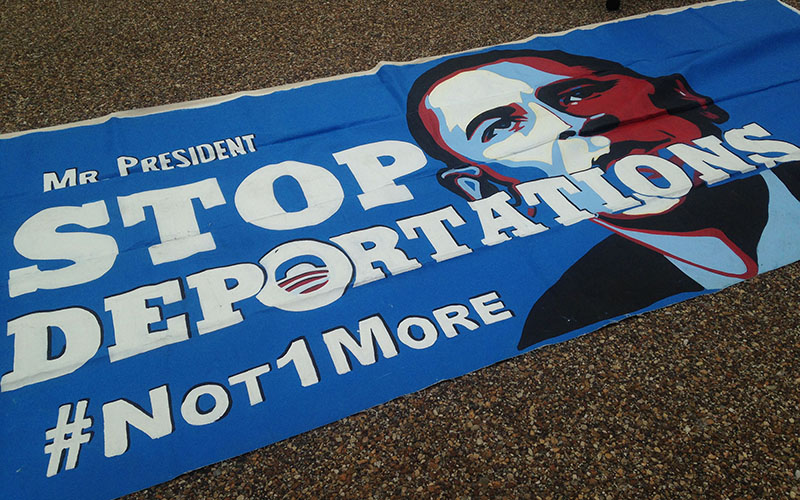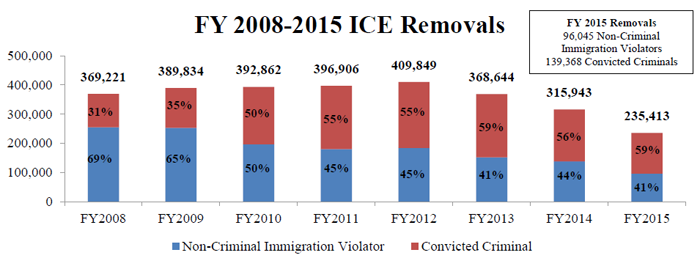
President Barack Obama was criticized as “deporter in chief” for policies that led to the removal of a record 2.5 million people during his tenure. President-elect Donald Trump could match thos numbers while dramatically shifting the focus of enforcement. (Photo by Whitney Ogden/Cronkite News)
WASHINGTON – President-elect Donald Trump’s most recent immigration pledge is to deport undocumented immigrants with criminal records, which he estimates at 2 million to 3 million immigrants – or roughly the same number deported by outgoing President Barack Obama.
Critics derided Obama as “deporter-in-chief” for his policies that led to the deportations of 2.5 million people, according to Immigration and Customs Enforcement data, more than any other president and almost more than all previous administrations combined.
But while Trump’s latest proposal, outlined in an interview with “60 Minutes,” would match Obama in terms of numbers, experts say it would be a sharp departure in enforcement tactics, shifting the focus to people living in the interior of the country and away from the borderlands where most of the deportations under the current administration took place.
They also say that the “different enforcement dynamic” being advocated by Trump could lead to the deportation of 2 million people within four years – half the time it took the Obama administration.
“What we’ve seen in the last eight years is the creation of this significant deportation apparatus,” said Jose Magana-Salgado, managing policy attorney at the Immigrant Legal Resource Center. He said Trump will easily match Obama’s record because the “resources are there they just need to be directed.”
While Trump appears to have backed off his campaign promise to deport all of the estimated 11 million immigrants living in this country illegally, experts say he will be hard-pressed to deport the millions who he said are living here with criminal records – because there just aren’t that many.
Faye Hipsman, a policy analyst at the Migration Policy Institute, said many of those immigrants Trump refers to are here legally. She said her organization, using numbers from the Department of Homeland Security, estimates that there are just 820,000 immigrants who are both here illegally and have criminal records.
That’s “a lot smaller, based on a number DHS released saying that there’s 1.9 million deportable immigrants based on criminal conviction, which includes a lot of people who are here legally, like those with green cards,” Hipsman said.

Deportations under the Obama administration have topped 2.5 million, according to U.S. Immigrations and Customs Enforcement. (Chart courtesy U.S. Immigration and Customs Enforcement)
Even the lower number of immigrants cited by MPI includes individuals “who have only committed minor traffic offenses or immigration violations,” according to a statement from the American Immigration Council. If Trump were to target only those with serious offenses, MPI said, the number would drop yet again: Of the 820,000, an estimated “300,000 had a felony conviction and 390,000 were serious misdemeanants.”
But advocates for stricter immigration control said Trump should not adopt a definition of criminal that only “includes serious, violent felons, independent of the immigration violations.” That definition of criminal is too “narrow and restrictive,” said Dan Stein, president of the Federation for American Immigration Reform.
“There’s no public consensus for, ‘How bad does the crime have to be?'” Stein said. “You have a million people now approximately, who are fugitives … regardless of whether they had another offense or not, who thumbed their nose at the system and disappeared.
“You got a million right there. Probably have six, seven, eight hundred thousand who have been released by DHS,” Stein said.
It is unclear if Trump plans to focus just on undocumented immigrants with criminal records, Hipsman said, or if he will begin removing immigrants who are in the U.S. legally but may have committed a crime. She and others say the latter would require a significant shift to “ramp up removals” in the interior.
“I do think this administration will likely resume interior immigration raids,” Magana-Salgado said. “We’re going to go back to an era where if you run into ICE they will deport you. We are entering into a phase where likely anyone can be targeted for deportation.”
He predicts that a Trump administration could deport in “the high 400,000s a year, with 2 million at the end of four years.”
Whatever the number, Hipsman said, “If he follows through with more removals, it will cause a lot more fear within immigrants.” And any significant increase would likely “need the cooperation of Congress and he would need Congress to approve increased funding to allow DHS to reach those levels of deportation.”
“Based on how contended the topic is … it’s unclear whether he can be successful in getting that money from Congress,” she said.